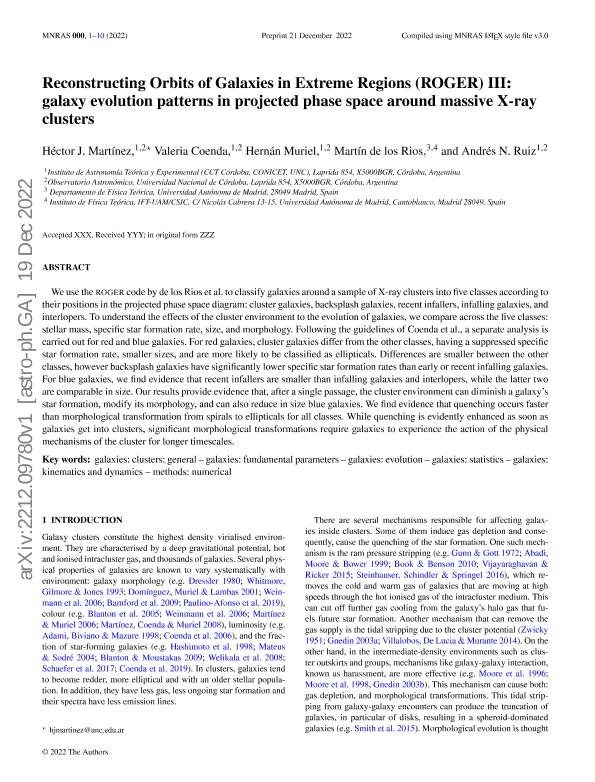Mostrar el registro sencillo del ítem
dc.contributor.author
Martinez, Hector Jose Ariel

dc.contributor.author
Coenda, Valeria

dc.contributor.author
Muriel, Hernan

dc.contributor.author
de Los Rios, Martín Emilio

dc.contributor.author
Ruiz, Andrés Nicolás

dc.date.available
2024-01-31T13:22:35Z
dc.date.issued
2023-03
dc.identifier.citation
Martinez, Hector Jose Ariel; Coenda, Valeria; Muriel, Hernan; de Los Rios, Martín Emilio; Ruiz, Andrés Nicolás; Reconstructing orbits of galaxies in extreme regions (ROGER) III: Galaxy evolution patterns in projected phase space around massive X-ray clusters; Wiley Blackwell Publishing, Inc; Monthly Notices of the Royal Astronomical Society; 519; 3; 3-2023; 4360-4369
dc.identifier.issn
0035-8711
dc.identifier.uri
http://hdl.handle.net/11336/225326
dc.description.abstract
We use the roger code by de los Rios et al.To classify galaxies around a sample of X-ray clusters into five classes according to their positions in the projected phase space diagram: cluster galaxies, backsplash galaxies, recent infallers, infalling galaxies, and interlopers. To understand the effects of the cluster environment to the evolution of galaxies, we compare across the five classes: stellar mass, specific star formation rate, size, and morphology. Following the guidelines of Coenda et al., a separate analysis is carried out for red and blue galaxies. For red galaxies, cluster galaxies differ from the other classes, having a suppressed specific star formation rate, smaller sizes, and are more likely to be classified as ellipticals. Differences are smaller between the other classes, however backsplash galaxies have significantly lower specific star formation rates than early or recent infalling galaxies. For blue galaxies, we find evidence that recent infallers are smaller than infalling galaxies and interlopers, while the latter two are comparable in size. Our results provide evidence that, after a single passage, the cluster environment can diminish a galaxy's star formation, modify its morphology, and can also reduce in size blue galaxies. We find evidence that quenching occurs faster than morphological transformation from spirals to ellipticals for all classes. While quenching is evidently enhanced as soon as galaxies get into clusters, significant morphological transformations require galaxies to experience the action of the physical mechanisms of the cluster for longer time-scales.
dc.format
application/pdf
dc.language.iso
eng
dc.publisher
Wiley Blackwell Publishing, Inc

dc.rights
info:eu-repo/semantics/openAccess
dc.rights.uri
https://creativecommons.org/licenses/by-nc-sa/2.5/ar/
dc.subject
GALAXIES: CLUSTERS: GENERAL
dc.subject
GALAXIES: EVOLUTION
dc.subject
GALAXIES: FUNDAMENTAL PARAMETERS
dc.subject
GALAXIES: KINEMATICS AND DYNAMICS
dc.subject
GALAXIES: STATISTICS
dc.subject.classification
Astronomía

dc.subject.classification
Ciencias Físicas

dc.subject.classification
CIENCIAS NATURALES Y EXACTAS

dc.title
Reconstructing orbits of galaxies in extreme regions (ROGER) III: Galaxy evolution patterns in projected phase space around massive X-ray clusters
dc.type
info:eu-repo/semantics/article
dc.type
info:ar-repo/semantics/artículo
dc.type
info:eu-repo/semantics/publishedVersion
dc.date.updated
2024-01-30T14:14:11Z
dc.journal.volume
519
dc.journal.number
3
dc.journal.pagination
4360-4369
dc.journal.pais
Reino Unido

dc.journal.ciudad
Londres
dc.description.fil
Fil: Martinez, Hector Jose Ariel. Consejo Nacional de Investigaciones Científicas y Técnicas. Centro Científico Tecnológico Conicet - Córdoba. Instituto de Astronomía Teórica y Experimental. Universidad Nacional de Córdoba. Observatorio Astronómico de Córdoba. Instituto de Astronomía Teórica y Experimental; Argentina. Universidad Nacional de Córdoba. Observatorio Astronómico de Córdoba; Argentina
dc.description.fil
Fil: Coenda, Valeria. Consejo Nacional de Investigaciones Científicas y Técnicas. Centro Científico Tecnológico Conicet - Córdoba. Instituto de Astronomía Teórica y Experimental. Universidad Nacional de Córdoba. Observatorio Astronómico de Córdoba. Instituto de Astronomía Teórica y Experimental; Argentina. Universidad Nacional de Córdoba. Observatorio Astronómico de Córdoba; Argentina
dc.description.fil
Fil: Muriel, Hernan. Consejo Nacional de Investigaciones Científicas y Técnicas. Centro Científico Tecnológico Conicet - Córdoba. Instituto de Astronomía Teórica y Experimental. Universidad Nacional de Córdoba. Observatorio Astronómico de Córdoba. Instituto de Astronomía Teórica y Experimental; Argentina. Universidad Nacional de Córdoba. Observatorio Astronómico de Córdoba; Argentina
dc.description.fil
Fil: de Los Rios, Martín Emilio. Consejo Nacional de Investigaciones Científicas y Técnicas. Centro Científico Tecnológico Conicet - Córdoba. Instituto de Astronomía Teórica y Experimental. Universidad Nacional de Córdoba. Observatorio Astronómico de Córdoba. Instituto de Astronomía Teórica y Experimental; Argentina. Universidad Autónoma de Madrid; España. Consejo Superior de Investigaciones Científicas; España
dc.description.fil
Fil: Ruiz, Andrés Nicolás. Consejo Nacional de Investigaciones Científicas y Técnicas. Centro Científico Tecnológico Conicet - Córdoba. Instituto de Astronomía Teórica y Experimental. Universidad Nacional de Córdoba. Observatorio Astronómico de Córdoba. Instituto de Astronomía Teórica y Experimental; Argentina. Universidad Nacional de Córdoba. Observatorio Astronómico de Córdoba; Argentina
dc.journal.title
Monthly Notices of the Royal Astronomical Society

dc.relation.alternativeid
info:eu-repo/semantics/altIdentifier/url/https://academic.oup.com/mnras/advance-article/doi/10.1093/mnras/stac3746/6948351
dc.relation.alternativeid
info:eu-repo/semantics/altIdentifier/doi/http://dx.doi.org/10.1093/mnras/stac3746
dc.relation.alternativeid
info:eu-repo/semantics/altIdentifier/arxiv/https://arxiv.org/abs/2212.09780
Archivos asociados
